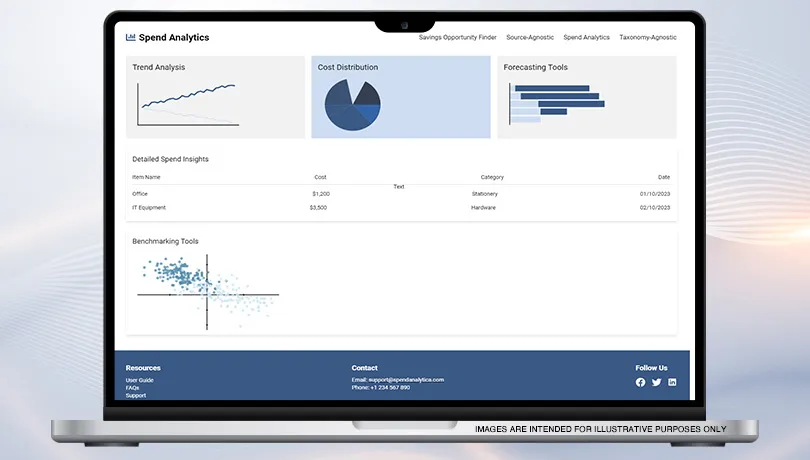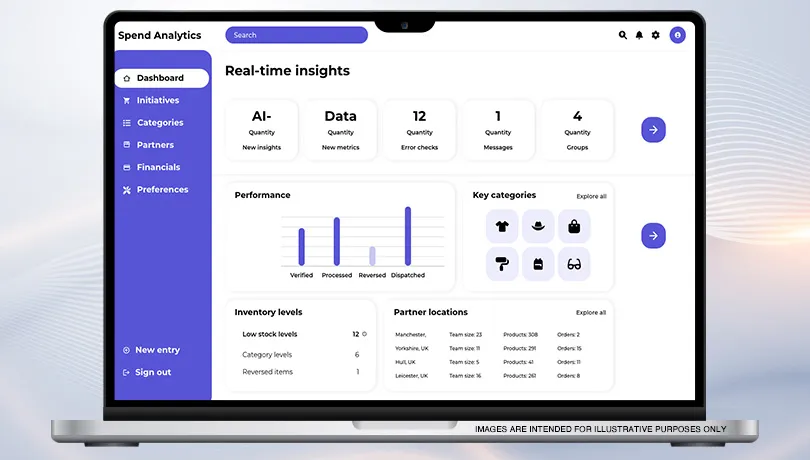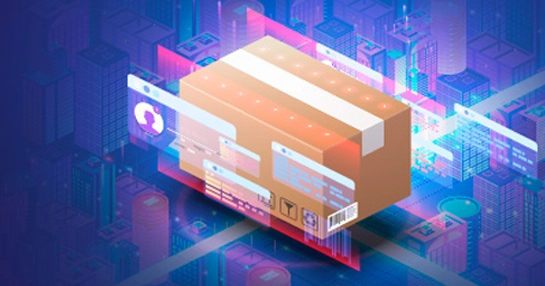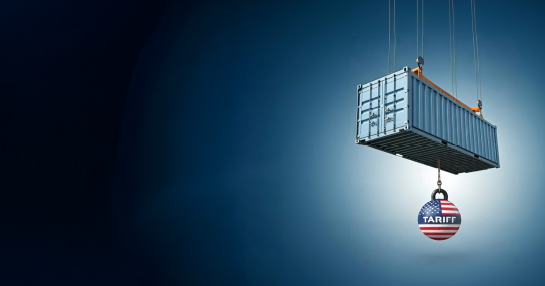Data Consolidation and Analysis
Spend analysis involves gathering and organizing your enterprise's spending data from various sources. This data is cleaned, standardized, and categorized to provide clear insights into purchasing patterns. Spend analytics tools, like GEP SMART™, use AI to process large amounts of data efficiently and accurately. By understanding your spending trends, you can identify opportunities for savings and improve your procurement strategy.

The Benefits of Spend Analytics
- Validate and classify data for accurate analysis and reports
- Remove duplicate orders and payments, spot price discrepancies
- Enhance supplier relationship management
- Drive transformation in your procurement strategy
- Reduce risk and increase cost-saving opportunities

Unified Procurement Platform
Spend Analysis
Advanced AI technology extracts real-time, deep insights from your spend data, enabling you to understand spend quickly and easily and optimize savings opportunities based on your sourcing strategy.
Savings Tracking
Gain real-time visibility into your cost-savings initiatives and their impact. AI eliminates redundancy and error from data capture, tracking and measurement.
Sourcing
Advanced AI capabilities can streamline the process of identifying, evaluating and qualifying new suppliers, shortening the RFx-to-award cycle and helping you achieve best-value agreements.
Contract Management
Generative AI systems reduce the time, effort and paper used to create, manage and monitor contracts, boosting contract utilization and increasing spend compliance.
Supplier Management
Generative AI enhances supplier relationships by offering insights to improve negotiations, contract management and dispute resolution, while also facilitating collaboration and engagement with suppliers.
Procure-to-Pay
Leverage AI to accelerate adoption, maximize spend under management through an intuitive, conversational purchasing experience, optimize compliance, and reduce the req-to-pay cycle time.
FAQ
When evaluating spend analytics software, the procurement organization should prioritize solutions that offer comprehensive data aggregation capabilities. The system must effectively collect, cleanse, and normalize data from disparate sources — ERP systems, travel systems, contract repositories, and so on — creating a unified view of organizational spend.
Data classification functionality is paramount. Look for solutions with advanced AI and machine learning algorithms that can accurately categorize spend into a logical taxonomy with minimal manual intervention.
Robust visualization capabilities transform complex spending patterns into actionable insights. The solution should offer configurable dashboards and interactive drill-down functionality, enabling category managers to identify saving opportunities at various organizational levels.
Supplier risk monitoring features are increasingly critical. Advanced spend analytics software platforms should be able to integrate external data sources to provide real-time insights into supplier financial health, compliance status, and geopolitical risk exposure.
Contract compliance monitoring helps identify maverick spend and off-contract purchasing. The software should automatically flag transactions outside negotiated agreements, quantifying leakage in real-time.
Predictive analytics capabilities distinguish truly advanced solutions. These features leverage historical spending patterns to forecast future requirements, identify potential supply disruptions, and recommend proactive interventions.
User experience remains essential, as even the most powerful analytics engine fails if adoption lags. Intuitive interfaces, mobile accessibility, and self-service reporting encourage extensive use across the procurement function.
Finally, evaluate integration capabilities. The solution should seamlessly connect with your existing technology stack, including ERP systems, source-to-pay platforms, and supplier management tools.
By prioritizing these features, procurement teams can select spend analytics tools that deliver meaningful insights rather than merely report historical data.
Spend analytics software serves as the technological backbone of strategic procurement, transforming raw transaction data into actionable business intelligence. At its core, this specialized solution aggregates purchasing information from multiple systems — including ERP platforms, procurement cards, and accounts payable — to create a comprehensive spending profile.
Once data is collected, the software employs sophisticated algorithms to cleanse and normalize information, addressing inconsistencies in supplier naming, part numbers, and classification codes. This normalization process establishes a single source of truth for all procurement activities.
Advanced classification engines then categorize each transaction according to standardized taxonomies (such as UNSPSC or custom frameworks), enabling accurate analysis across commodity groups. This classification powers meaningful spend visibility that transcends departmental or regional boundaries.
Advanced spend analytics platforms deliver multidimensional analysis capabilities, enabling procurement teams to examine spending patterns by supplier, category, business unit, geography, and time period. These insights reveal consolidation opportunities, compliance issues, and potential negotiation leverage.
Beyond reporting, these solutions offer predictive capabilities that forecast future spending patterns, identify savings opportunities, and suggest strategic interventions. They also facilitate supplier rationalization by highlighting fragmented spending across similar vendors.
The most sophisticated platforms incorporate market intelligence, benchmarking organizational performance against industry standards and flagging opportunities to realign spending with market conditions.
The imperative for robust spend analytics tools has never been greater as organizations navigate increasingly complex supply markets and heightened cost pressures. Without comprehensive spend visibility, procurement teams are left with no option but to operate in a reactive state, unable to strategically influence organizational spending or mitigate supply risks.
Spend analytics tools address this fundamental challenge by providing granular visibility into enterprise-wide expenditures. This visibility enables procurement to identify strategic sourcing opportunities that might otherwise remain hidden in organizational silos. For many businesses, consolidating fragmented spend across similar suppliers typically yields considerable savings in affected categories.
These tools also enhance compliance monitoring, helping procurement teams to identify maverick spending and off-contract purchasing. By quantifying contract leakage, organizations can implement targeted interventions that drive greater adherence to negotiated agreements.
Supplier risk management represents another critical need addressed by spend analytics. Modern platforms help organizations identify dangerous concentrations of spending with individual suppliers or geographic regions, enabling proactive diversification before disruptions actually occur.
For CFOs and finance leaders, spend analytics tools provide essential forecasting capabilities, supporting more accurate budget planning and cash flow management. The ability to track spending against budgets in real time helps prevent cost overruns and supports financial discipline.
As sustainability becomes increasingly important, spend analytics tools also help organizations track progress against environmental and social governance metrics, quantifying the impact of procurement decisions against broader corporate objectives.



















